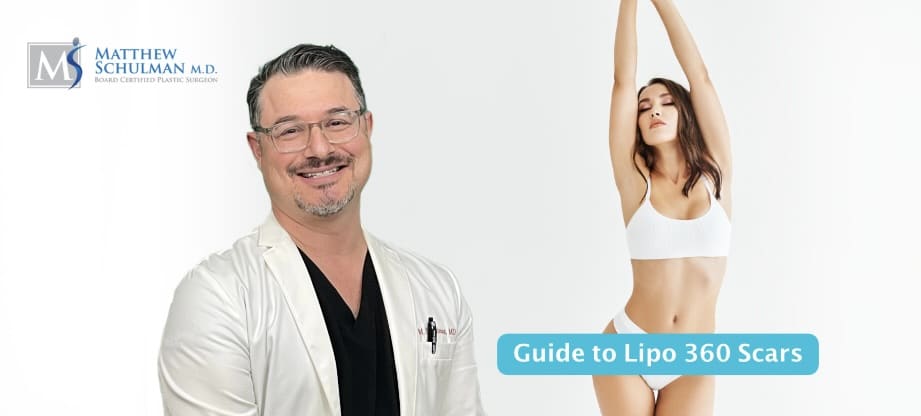The idea of lipo 360 scars can sometimes deter patients from pursuing this outstandingly effective plastic surgery procedure. Fortunately, liposuction scars are far from noticeable following surgery.
Below, we’ll explain further why 360 lipo scars are not something to be afraid of. But first, let’s outline how liposuction 360 is different from most traditional liposuction procedures.
Lipo 360 vs Traditional Liposuction
Liposuction 360 aims to remove stubborn fat from around the abdomen 360 degrees. This creates a comprehensive slimming of the entire midsection.
By contrast, if a patient requests “traditional liposuction” on the abdomen, it’s likely they only want to “spot treat” or specifically target areas such as the lower abdomen below the belly button or the flanks, for example.
 Does Lipo 360 Leave Scars?
Does Lipo 360 Leave Scars?
Yes. However, the good news is that surgical scars from lipo 360 are very small because only tiny incisions are necessary. This means they typically heal so well that they are hardly noticeable.
Where Will My 360 Lipo Scars Be Located?
Typically, with liposuction 360, your scars will be strategically placed to minimize visibility while effectively contouring your body. They may be placed in natural creases such as beneath the breasts or along the bikini line or in the belly button.
How Big Are Scars from Lipo 360?
Due to advancements in surgical techniques, it’s now possible to perform liposuction with smaller instruments, which means smaller incisions and smaller scars. In addition, while individual healing varies, most patients find that 360 lipo scars fade significantly over time. The majority of liposuction 360 scars are just a few millimeters to around a centimeter long at most.
What Do Liposuction 360 Scars Look Like?
Right after surgery, 360 lipo scars may appear red or pink and slightly raised. This is normal. Your body is doing all it can to improve the area and mend your wounds by sending collagen there to fix the damaged tissue and skin.
Over time, your liposuction scars will become less noticeable. They will flatten out and fade. Some people say they look only like a small freckle or dot after a few years. And even after a few months, they should be barely visible in most cases.
Feel free to look up “lipo 360 scars” in Google images to see some examples of normal scarring following this cosmetic procedure. You can also ask your surgeon to present lipo 360 before and after photos if they are available.
Types of Lipo 360 Scars
When it comes to Lipo 360, it’s important to understand that scarring can vary depending on how your body heals. While most scars from the procedure are small and fade significantly over time, it’s helpful to know the different types of scarring you might encounter during recovery. This knowledge can help set realistic expectations for healing and outcomes.
Incisional Scarring
Incisional scars are the most common type after Lipo 360. These result from the small, strategic incisions made during the procedure. Typically, these scars are placed in discreet areas, such as along the bikini line or within natural skin folds, so they’re less noticeable. Incisional scars usually heal well, often fading to the point of being barely visible after several months to a year.
They generally remain confined to the original incision site, making them relatively easy to manage.
Subcutaneous Scarring
Subcutaneous scarring occurs beneath the surface of the skin, as the cannula (the tool used for fat removal) moves through the tissue. This internal manipulation can lead to the formation of fibrous tissue, which may cause the skin to feel firmer or even look slightly uneven. While this type of scarring isn’t visible, it can impact the texture or elasticity of the skin.
To minimize subcutaneous scarring, proper post-operative care is essential. Gentle massage and wearing compression garments can help promote better healing and smoother results.
Keloid Scarring
Keloid scarring is much less common but can occur, especially in individuals prone to this type of scar. These scars extend beyond the original incision site and can appear raised, thick, and sometimes darker than regular scars. While rare, keloids can be more challenging to treat, so if you know you’re prone to them, it’s important to talk to your surgeon beforehand. There are options available, including treatments to help reduce their appearance if they do develop.
Minimizing Lipo 360 Scarring
Use the following tips to help minimize scarring appearance during your 360 liposuction recovery.
Use proper wound care.
Following your surgeon’s after surgery instructions is very important. Your specific instructions will depend on your surgeon and your unique surgery. They may include instructions on how to shower and tend to your incision sites, what not to do in terms of exercise, and how to use compression garments and topical treatments to avoid significant scarring.
Use silicone gel sheets.
There are several scar treatment products available, but silicone gel sheets tend to be the best. They are highly effective at keeping scars moisturized and softened, which helps them to lay flatter and blend better into the surrounding skin.
Consider massage.
Gentle massage of scarred areas promotes better blood flow, breaks up scar tissue, and aids with the healing process. Always consult with your cosmetic surgeon before trying massage after surgery.
Avoid exposure to the sun.
Exposing your scars to the sun can create darker scars that are generally more noticeable. We recommend using a high SPF sunscreen and covering your scarred skin with clothing whenever you go outside (yes, even on cloudy days!).
Why Is It Called “Lipo 360”?
The term “lipo 360” refers to liposuction performed around the entire circumference of the abdomen, targeting all areas of the midsection for comprehensive body contouring. The “360” denotes a full circle, representing liposuction performed all the way around the torso instead of just in certain spots.
Interestingly, this term was coined by patients themselves to describe the procedure’s comprehensive nature and its ability to sculpt the entire abdominal area.
Can Lipo 360 Scars Be Treated with Laser Therapy?
Yes, laser therapy is an option for treating Lipo 360 scars, especially if they become more noticeable or if you develop hypertrophic or keloid scarring. Laser treatments are effective at improving the appearance of scars by targeting the skin’s surface and stimulating collagen production.
How Laser Therapy Works
Laser therapy uses focused light to break down scar tissue and encourage the skin to heal more evenly. The treatment can help flatten raised scars, improve color, and smooth the texture of the skin. It works well for both surface-level scars and deeper ones, including subcutaneous scarring.
When to Consider Laser Therapy
Laser therapy is usually recommended if you notice that your scars are not fading as expected or if they appear to be growing thicker or discolored. It’s a non-invasive solution that can be performed after your wounds have fully healed, usually a few months after surgery.
Benefits of Laser Therapy
- Reduces redness and discoloration in scars
- Helps flatten hypertrophic or keloid scars
- Smooths out uneven skin texture
- Promotes faster healing and better overall skin appearance
If you’re concerned about your scars after Lipo 360, it’s a good idea to discuss laser therapy with your surgeon or dermatologist. They’ll help determine if it’s the right option based on your skin type, healing progress, and scar appearance.
FAQ: Liposuction 360 Scarring
What are keloid scars?
Keloid scars are raised hyperpigmentation scars. Unlike normal scars, keloids frequently extend beyond the concentrated area of the initial incision. Unlike hypertrophic scars, they can actually become far bigger than the original incision site, in fact. Keloid scarring occurs in rare instances, usually among patients who are prone to them.
Your risk of developing keloid scars from liposuction is small, but if it does occur, laser therapy and other scar removal treatments exist that can help reduce their appearance.
 How long does lipo 360 last?
How long does lipo 360 last?
Liposuction is a safe and effective way to sculpt your body, and the results can last for a lifetime with proper care.
How many inches does lipo 360 take off?
With 360 Lipo, you can typically expect to lose around two inches from your waist. As a general rule, you lose about an inch for every five pounds of fat removed. Of course, the exact results will depend on how much fat is removed during your procedure.
Does liposuction leave scars on the abdomen?
Yes, a liposuction procedure on the abdomen will leave scars. The good news is that liposuction incisions are tiny, and very visible scars after healing are rare.
Can I get 360 Lipo without tummy tuck surgery?
Yes, you can undergo the comprehensive fat removal approach of Lipo 360 without requiring a tummy tuck. This minimally invasive procedure utilizes small incisions and a cannula to sculpt a more contoured physique by eliminating excess fat.
Book Your Lipo 360 Consultation Today
If visible scarring after 360 liposuction surgery has kept you from seeking more information about this cosmetic surgery, we invite you to book a consultation with Dr. Matthew Schulman. Meeting in person with your cosmetic surgeon will allow you to learn more details about the procedure and whether you need actually be concerned about scarring.
Board-certified plastic surgeon Dr. Matthew Schulman is an expert in body contouring, which includes removing excess fat around the midsection with liposuction 360. Find out more about liposuction 360 and how to manage liposuction scars by giving our office a call today and scheduling a consultation with Dr. Schulman.



 Does Lipo 360 Leave Scars?
Does Lipo 360 Leave Scars? How long does lipo 360 last?
How long does lipo 360 last?
